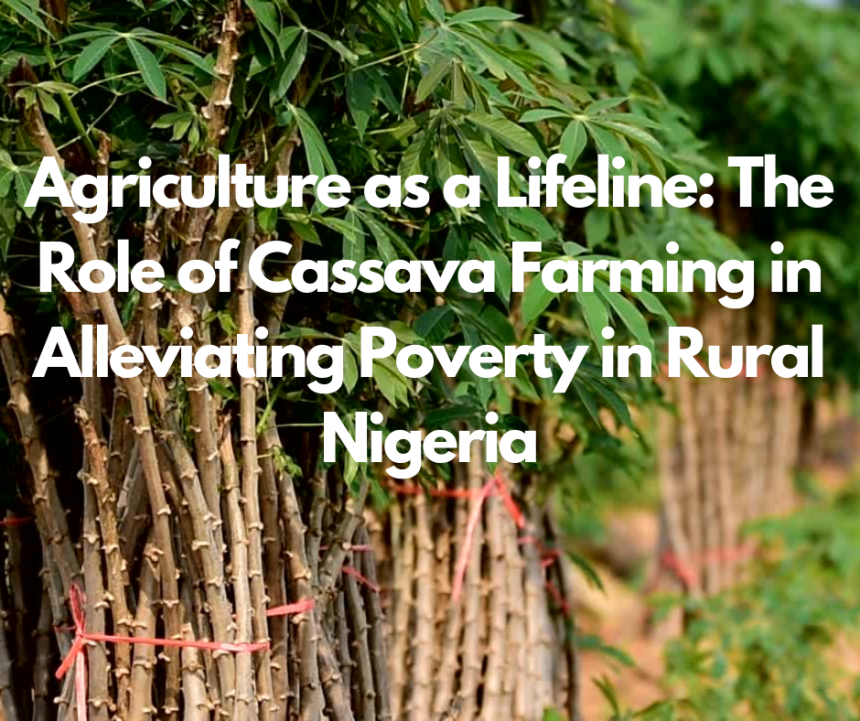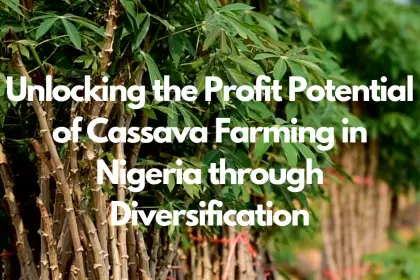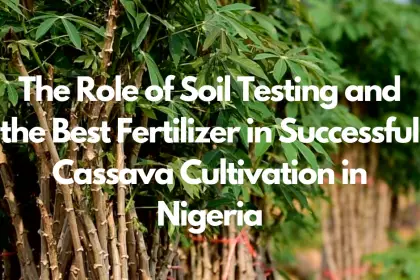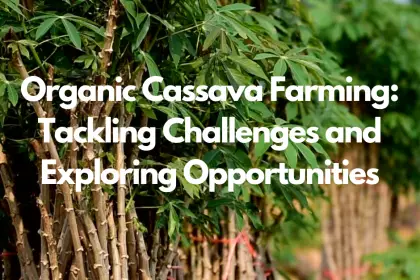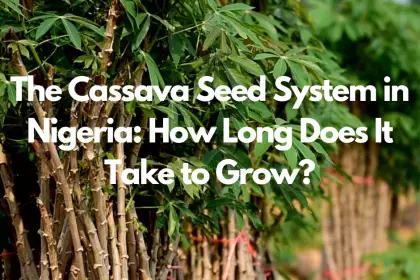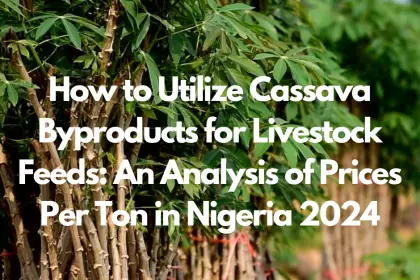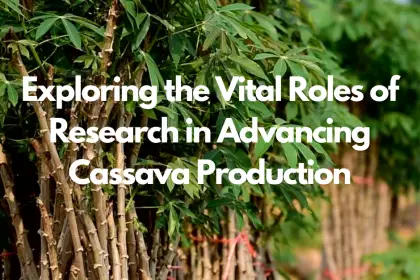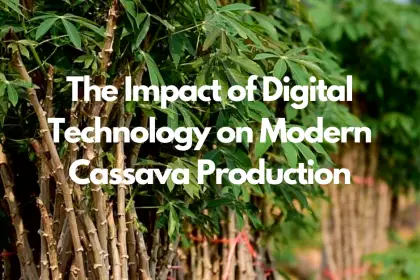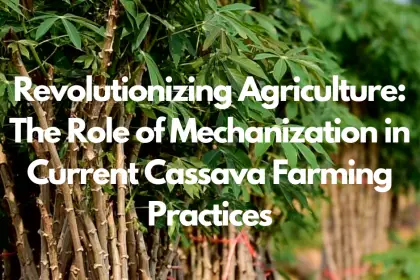Nigeria, known as the world’s largest producer of cassava, boasts an annual production exceeding 34 million tonnes, with cassava farming holding significant promise for poverty alleviation in rural areas. This
The Socio-economic Importance of Cassava in Nigeria
Nigeria’s distinction as the world’s largest producer of cassava, with an annual output surpassing 34 million tonnes, underscores the crop’s pivotal role in the nation’s socio-economic fabric. The upward trajectory in cassava production over the past two decades, marked by increased land cultivation and yield per hectare, is attributed to several key factors:
- Demographic and Market Dynamics: The surge in production aligns with rapid population growth and a substantial internal market demand.
- Innovative Agricultural Practices: The adoption of high-yielding improved varieties, alongside advancements in processing technology, has significantly enhanced productivity.
- Infrastructure and Market Organization: A relatively well-developed market access infrastructure and a well-organized internal market structure have facilitated the growth of the cassava sector.
Furthermore, cassava’s adaptability to diverse farming systems, owing to its year-round availability, tolerance to adverse agricultural conditions, and minimal industrial usage, positions it as a critical food crop for smallholder farmers. This is particularly significant in Nigeria, where the average farm size is 1.6 hectares, and the farming/processing experience averages 22 years, indicating a deep-rooted reliance on cassava for livelihood sustenance. The socio-economic impact of cassava farming extends beyond food security, offering a substantial source of cash income for farmers and playing a vital role in poverty alleviation. A notable aspect of the cassava economy is the prominent role of women, who contribute significantly to production, processing, and marketing efforts, thereby enhancing household welfare and community development.
Despite these advancements, challenges persist, such as the low yield per hectare in comparison to other countries, attributed to factors like the land tenure system and the threat of land speculation in peri-urban areas. Addressing these challenges through government intervention, non-governmental support, and the adoption of improved cassava varieties could further bolster the socio-economic benefits of cassava farming, making it an even more potent tool for rural development and poverty eradication in Nigeria.
Challenges Facing Cassava Farmers
Cassava farmers in Nigeria face a myriad of challenges that hamper the productivity and sustainability of their farming practices. These challenges can be broadly categorized into issues related to farming practices, financial constraints, and environmental impacts.
- Farming Practices and Constraints:
-
- The majority of cassava production is carried out by small-scale farmers who rely on rudimentary tools and have an average landholding of less than two hectares.
- A significant portion of farmers does not have access to agricultural technology due to factors such as high levels of illiteracy, non-availability of inputs, and the high cost of agricultural services.
- Pests and diseases, including Cassava Mosaic Disease and Cassava Bacterial Blight, pose serious threats to yield.
- Technical challenges such as low nutritive quality, post-harvest physiological degradation, and high cyanogenic levels further complicate cassava farming.
- Financial and Cooperative Challenges:
-
- A staggering 62.6% of farmers lack access to farm credit, and 53.2% are not members of any cooperative associations, which significantly impacts their ability to adopt new technologies and improve production.
- The absence of adequate funds and the high rate of poverty among farmers restrict their ability to invest in better farming practices.
- Environmental Concerns and Climate Change:
-
- Cassava farming, if not managed responsibly, can lead to habitat destruction and soil degradation.
- Climate change introduces additional stressors, including reduced biodiversity, increased crop failure, and decreased yields, necessitating the adoption of adaptation strategies such as planting improved cassava varieties and relying on climate information.
These challenges underscore the need for targeted interventions to support cassava farmers in Nigeria, including access to credit, technological innovations, and strategies to mitigate environmental impacts.
Strategies for Enhancing Cassava Production
To enhance cassava production in Nigeria, a multifaceted approach is essential, focusing on the adoption of improved agricultural technologies, effective land preparation, and the strategic use of fertilizers. The integration of these strategies promises to uplift cassava farming from subsistence to a more productive and sustainable level, thereby contributing significantly to rural development and food security.
- Adoption of Improved Agricultural Technologies:
-
- Utilization of improved cassava stem varieties from institutions like the International Institute of Tropical Agriculture (IITA) or National Root Crops Research Institute, Umudike.
- Mechanization of farming practices, including plowing, ridging, and harrowing, to increase efficiency and reduce labor costs.
- Implementation of effective systems for the multiplication and distribution of disease-free planting material of improved varieties.
- Strategic Land Preparation and Planting Techniques:
-
- Selection of fertile, well-drained land, preferably flat or gently sloping.
- Use of cuttings that are disease-free, freshly harvested, and of the correct size and length.
- Proper spacing of cuttings at 1 m x 1 m and adopting intercropping practices with crops like soybean and cowpea to optimize land use.
- Optimal Use of Fertilizers and Weed Control:
-
- Application of a minimum of four bags of fertilizer per hectare following the ‘4Rs’: Right type, Right rate, Right timing, and Right method.
- Regular weed control starting 3-4 weeks after planting, utilizing both chemical and manual methods to ensure a well-weeded farm, which can yield 30-40% more roots than a poorly weeded one.
These strategies, when effectively implemented, have the potential to significantly improve cassava yields, enhance food security, and contribute to poverty alleviation in rural Nigeria.
Case Studies of Successful Cassava Farming Projects
The Cassava Mechanisation and Agro-processing Project (CAMAP), operational in Nigeria, particularly in Osun state, exemplifies a successful initiative aimed at enhancing cassava production. A notable beneficiary, Mrs. Kikelomo Amusan, leveraged the project’s offerings to cultivate an expanse of over one acre of cassava. The project facilitated her efforts by providing:
- Quality stem cuttings essential for healthy plant growth.
- Fertiliser to enrich the soil and boost cassava yield.
- Pre-emergence herbicide to control weeds efficiently.
Another compelling case study involves Farmer A, a Ghanaian who has been residing in Nigeria since 2018. His journey into cassava farming began in 2019 on a modest two-acre plot. Remarkably, his farming venture expanded to 30 acres by 2021, with his operations yielding approximately 40,000 per harvest. This growth not only highlights the scalability of cassava farming but also underscores the potential for substantial income generation from diligent and well-managed cassava cultivation efforts. These case studies collectively illustrate the tangible benefits of targeted agricultural projects and individual entrepreneurial spirit in elevating cassava farming as a viable means for poverty alleviation in rural Nigeria.
The Role of Technology and Innovation in Cassava Farming
In the realm of cassava farming, technological innovation and genomic resources have been pivotal in enhancing productivity and disease resistance, crucial for rural development and food security in Nigeria. These advancements include:
- Genomic Resources:
-
- Thousands of simple sequence repeats (SSR) markers, a chromosome-scale reference genome, and a cassava haplotype map featuring over 25.9 million SNPs and 19 million indels.
- High-throughput genotyping platforms like the GoldenGate assay and cost-effective genotyping technologies such as genotyping by sequencing.
- Molecular Markers and Phenotyping:
-
- Molecular markers play a vital role in confirming the uniqueness of accessions, guiding parental selection, and validating crosses.
- Phenotyping approaches are employed for assessing nutrition, yield components, quality, biotic stresses, and root system architecture. Near-infrared spectroscopy (NIRS) aids in quantifying carotenoids and predicting dry matter content.
- Genotype-Phenotype Association Studies:
-
- Studies, including classical QTL mapping and genome-wide association studies (GWAS), identify genes or quantitative trait loci (QTLs) linked to traits like disease resistance (cassava mosaic disease, cassava brown streak disease, cassava green mite, cassava bacterial blight, and cassava root rot) and quality attributes (carotenoids, storage root color, cyanogenic glucosides, and dry matter content).
These technological and genomic advancements underscore the importance of integrating scientific research with agricultural practices to bolster cassava production, a critical step towards achieving rural development and alleviating poverty in Nigeria.
Conclusion
Through this exploration of cassava farming in Nigeria, we’ve underscored its vital contribution to the socio-economic landscape, particularly in alleviating poverty in rural communities. The cultivation, processing, and marketing of cassava not only provide a critical food source but also generate significant income for smallholder farmers, harnessing the potential of women in the process and reinforcing household and community development. However, this promising avenue is not without its challenges, including infrastructural limitations, disease management, and the need for financial and technological support. Addressing these hurdles through concerted efforts involving government, non-governmental organizations, and the farming community itself has the potential to further solidify cassava’s role in Nigeria’s path towards sustainable development.
The integration of technological and innovative strategies into cassava farming reflects a forward-looking approach to enhancing production and disease resistance, marking key steps towards food security and rural development. The introduction of improved agricultural practices, alongside case studies of successful farming initiatives, celebrate the resilience and entrepreneurial spirit of Nigerian farmers. Moving forward, the continued embracement of innovative solutions and support frameworks will be crucial in surmounting existing challenges, thereby paving the way for enriched livelihoods through cassava farming and contributing to the overarching goal of poverty alleviation in rural Nigeria.
FAQs
Q: How does agriculture contribute to reducing poverty in Nigeria?
A: In Nigeria, there is a substantial connection between agriculture and poverty reduction. For every unit increase in the inflation rate, poverty decreases by 2.5%. More importantly, there is a significant negative correlation between agricultural output and poverty levels, where a unit increase in agricultural output leads to a 1.7% decrease in poverty.
Q: Why is cassava considered significant in the agricultural sector?
A: Cassava is a versatile crop that serves as the foundation for a wide array of products. These include food items, flour, animal feed, alcoholic beverages, starch for paper and textile sizing, sweeteners, various prepared foods, and even bio-degradable materials. The crop can be utilized in many forms, from fresh leaves and roots to processed starches.
Q: What makes cassava a critical staple crop in Nigeria?
A: Cassava is a crucial food crop for smallholder farmers in Nigeria because it is available throughout the year, ensuring consistent household food security. It is also a hardy crop, more resilient than grains to adverse conditions such as poor soil quality, drought, and common pests and diseases.
Q: What challenges are associated with cassava farming in Nigeria?
A: Cassava farmers in Nigeria face numerous challenges, including a variety of pests and diseases like cassava mosaic disease, cassava bacterial blight, and others. They also contend with weather-related issues, poor soil quality, land degradation, damage caused by livestock, and other dangers that can affect crop yield and quality.

